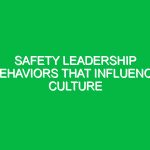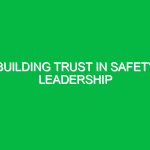In the realm of Health, Safety, and Environment (HSE), engaging senior management in safety efforts is not merely an option; it is a necessity. The commitment of senior leaders can significantly influence the culture of safety within an organization, shaping policies, practices, and attitudes toward risk management. When senior management actively participates in safety efforts, it sends a powerful message throughout the organization: safety is a priority. This article explores the importance of engaging senior management in safety initiatives, the risks associated with inadequate engagement, best practices for involvement, and relevant regulations that guide these efforts.
Understanding the Importance of Senior Management Engagement in Safety Efforts
Engaging senior management in safety efforts means involving top executives in safety initiatives, ensuring their active participation in decision-making processes related to health and safety. This engagement is crucial because it fosters a safety-first mentality across all levels of an organization. When management is visibly committed to safety, employees are more likely to prioritize it in their daily activities. A study by the National Safety Council revealed that organizations with strong safety leadership had a 70% lower injury rate compared to those without it.
Moreover, senior management involvement is essential for allocating resources, implementing effective safety programs, and ensuring compliance with various regulations. When leaders demonstrate a genuine commitment to safety, it cultivates trust and encourages employees to report hazards or near-misses without fear of repercussions. This open communication is vital in identifying potential risks before they escalate into serious incidents.
Identifying Potential Hazards and Risks in Senior Management Engagement
While engaging senior management in safety efforts is beneficial, it is not without its challenges. Several hazards and risks can arise from inadequate engagement or poorly executed safety programs:
1. Lack of Awareness
One of the primary risks is the lack of awareness among senior leaders regarding the specific safety challenges faced by frontline workers. For instance, a manufacturing company might have executives who are unaware of the daily hazards employees encounter, such as operating heavy machinery or handling hazardous materials. This disconnect can lead to ineffective safety policies that do not address real-world risks.
2. Inadequate Resource Allocation
If senior management does not prioritize safety, the necessary resources—such as funding, training, and personnel—may be insufficient. For example, a construction firm might struggle to implement safety training programs due to budget constraints imposed by management, ultimately compromising worker safety.
3. Poor Communication
A lack of communication between senior leaders and employees can create an environment where safety concerns are not adequately addressed. If workers feel that their safety is not valued by management, they may refrain from reporting safety issues, leading to an increased risk of accidents.
Safety Precautions and Best Practices for Engaging Senior Management
To effectively engage senior management in safety efforts, organizations should adopt specific practices that foster a culture of safety. Here are some actionable strategies:
1. Foster Open Communication
Encouraging open dialogue between management and staff is essential. Regular safety meetings should be held where employees can voice concerns and share experiences. For example, at a large oil and gas company, weekly safety briefings allowed workers to highlight issues they faced in the field, prompting management to adjust safety protocols accordingly.
2. Set Clear Safety Goals
Developing measurable safety objectives can help align management with safety initiatives. For instance, a logistics company might set a goal to reduce workplace injuries by 30% within a year. This not only demonstrates leadership commitment but also provides a concrete target for the entire organization.
3. Lead by Example
Senior management should demonstrate their commitment to safety by participating in training sessions and safety audits. When executives wear personal protective equipment (PPE) and engage in safety drills, they model desired behaviors for employees. A notable example comes from a mining company where the CEO regularly joined safety inspections, reinforcing the importance of safety throughout the organization.
4. Invest in Training and Development
Providing continuous safety training is critical. Management should ensure that all employees, including themselves, receive regular training on safety protocols and emergency procedures. A healthcare provider, for instance, may implement biannual safety training sessions for all staff, emphasizing the importance of maintaining a safe work environment.
5. Recognize and Reward Safety Efforts
Acknowledging employees who prioritize safety can motivate others to follow suit. Implementing a recognition program, such as “Safety Employee of the Month,” can foster a culture that values safety. A construction company that introduced a reward system saw a marked increase in safety reporting and a decrease in incidents.
Regulations and Standards Governing Senior Management Engagement in Safety Efforts
Engaging senior management in safety efforts is not just a best practice; it is also a regulatory requirement in many industries. Understanding the relevant regulations can guide organizations in their safety strategies:
1. Occupational Safety and Health Administration (OSHA)
In the United States, OSHA regulations mandate that employers provide a safe workplace. Senior management plays a crucial role in ensuring compliance. For instance, OSHA’s General Duty Clause requires employers to keep their workplaces free from recognized hazards, highlighting the need for management engagement in safety efforts.
2. ISO 45001
The ISO 45001 standard provides a framework for occupational health and safety management systems, emphasizing the importance of leadership and worker participation. Organizations seeking certification must demonstrate that senior management is actively involved in safety initiatives, thus promoting a proactive safety culture.
3. Industry-Specific Regulations
Many industries have specific regulations that require senior management involvement in safety efforts. For example, in the construction industry, the Construction (Design and Management) Regulations (CDM) in the UK place a significant emphasis on the role of senior management in ensuring health and safety throughout the project lifecycle.
The Road Ahead: Building a Safety-First Culture
Engaging senior management in safety efforts is a critical component of fostering a culture where safety is prioritized. As organizations navigate the complexities of HSE, the commitment of leadership can set the tone for safety culture. By understanding potential risks, implementing best practices, and adhering to relevant regulations, organizations can create a safer work environment for all employees.
Ultimately, the journey toward effective safety engagement is a continuous process. It requires ongoing effort, reflection, and adaptation to the ever-evolving landscape of workplace safety. When senior management leads the charge, the entire organization benefits, resulting in a safer, more productive workplace.


